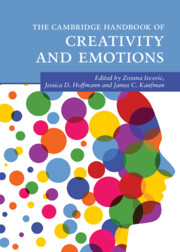Book contents
- The Cambridge Handbook of Creativity and Emotions
- Cambridge Handbooks in Psychology
- The Cambridge Handbook of Creativity and Emotions
- Copyright page
- Dedications
- Contents
- Figures
- Tables
- Contributors
- Acknowledgments
- Creativity and Emotions
- Part I Methods in the Study of Creativity and Emotions
- Part II The Development of Creativity
- Part III Emotions and the Creative Person
- Part IV Emotions and Creative Products
- 17 Emotional Creativity
- 18 Affective Factors in Dark Creativity
- 19 For Emotion’s Sake … The Centrality of Emotions in the Art Experience
- 20 The Affective Benefits of Creative Activities
- 21 Everyday Creativity as a Pathway to Meaning and Well-Being
- 22 Creative Arts Therapies
- 23 Developing Emotion Abilities through Engagement with the Arts
- Part V Emotions and Creativity at School and Work
- Index
- References
19 - For Emotion’s Sake … The Centrality of Emotions in the Art Experience
from Part IV - Emotions and Creative Products
Published online by Cambridge University Press: 16 February 2023
- The Cambridge Handbook of Creativity and Emotions
- Cambridge Handbooks in Psychology
- The Cambridge Handbook of Creativity and Emotions
- Copyright page
- Dedications
- Contents
- Figures
- Tables
- Contributors
- Acknowledgments
- Creativity and Emotions
- Part I Methods in the Study of Creativity and Emotions
- Part II The Development of Creativity
- Part III Emotions and the Creative Person
- Part IV Emotions and Creative Products
- 17 Emotional Creativity
- 18 Affective Factors in Dark Creativity
- 19 For Emotion’s Sake … The Centrality of Emotions in the Art Experience
- 20 The Affective Benefits of Creative Activities
- 21 Everyday Creativity as a Pathway to Meaning and Well-Being
- 22 Creative Arts Therapies
- 23 Developing Emotion Abilities through Engagement with the Arts
- Part V Emotions and Creativity at School and Work
- Index
- References
Summary
Emotions are some of the most discussed aspects of the experience of art, and it has even been argued that emotions are synonymous with art. This chapter will delve into how art simultaneously conveys and evokes emotions, a feature that helps to distinguish the experience of art from experiences in other areas of life. The chapter will also discuss the developments in research methodologies and trends in the scientific study of art that have brought our understanding of art from being based mainly on anecdotal evidence to being empirically-founded. The longstanding issues associated with emotions and art, as well as present state-of-the-art research on the role of emotions in aesthetic experiences, will also be presented. Finally, the chapter will identify some of the questions and challenges for future research in emotions and art.
- Type
- Chapter
- Information
- The Cambridge Handbook of Creativity and Emotions , pp. 358 - 375Publisher: Cambridge University PressPrint publication year: 2023



